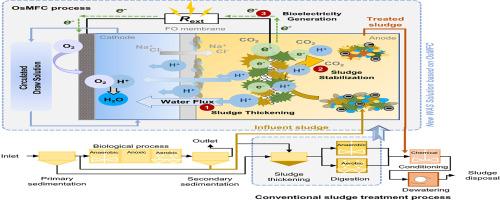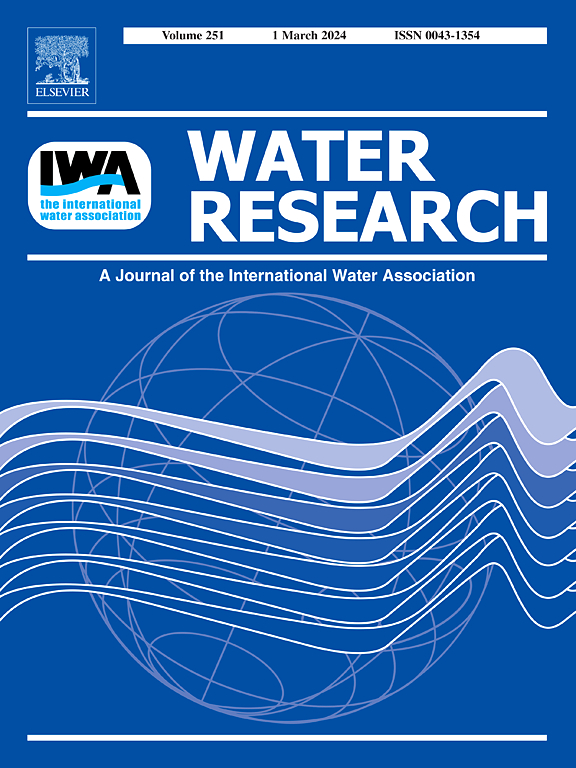An Innovative Application of Osmotic Microbial Fuel Cell (OsMFC) for Enhanced Activated Sludge Thickening and Stabilization with Bioelectricity Generation
IF 11.4
1区 环境科学与生态学
Q1 ENGINEERING, ENVIRONMENTAL
引用次数: 0
Abstract
Waste activated sludge (WAS) management presents significant challenges due to its complex composition and the high cost associated with conventional treatment methods. This study investigates the potential of osmotic microbial fuel cell (OsMFC) technology for WAS thickening, stabilization, and bioelectricity generation. Compared to conventional microbial fuel cells (MFCs), OsMFCs offer several advantages, including enhanced sludge thickening performance, improved organic matter degradation efficiency, and increased bioelectricity generation. The OsMFC achieved substantial sludge thickening, with the total suspended solids (TSS) increasing from 1,753, 11,650, and 3,565 mg/L in the OsMFC to 28,550, 28,500, and 20,340 mg/L, respectively, over three consecutive operating cycles with a sludge retention time of 16 days. The total chemical oxygen demand (tCOD) mass reduction in the OsMFC averaged 90.7%, outperforming the MFC, which achieved 61.3%. This indicates the superior performance of the OsMFC in organic sludge digestion. Further supporting this, the VSS/TSS ratio of treated WAS was effectively reduced from 0.64 to 0.37, with an average VSS mass reduction of 65.0% obtained in the OsMFC. Additionally, OsMFC treatment modified the physicochemical properties of the WAS, resulting in smaller floc particle size, and reduced zeta potential, potentially enhancing sludge dewaterability. Furthermore, OsMFC exhibited superior bioelectricity generation compared to MFC, with maximum power densities averaging 1,704.6 mW/m3, outperforming that of 762.3 mW/m3 observed in comparing MFC. Despite its promising potential, further research is needed to optimize OsMFC operation and fully understand its mechanisms. Overall, this study highlights the potential of OsMFC technology for sustainable and efficient management of WAS within the circular economy framework.

求助全文
约1分钟内获得全文
求助全文
来源期刊

Water Research
环境科学-工程:环境
CiteScore
20.80
自引率
9.40%
发文量
1307
审稿时长
38 days
期刊介绍:
Water Research, along with its open access companion journal Water Research X, serves as a platform for publishing original research papers covering various aspects of the science and technology related to the anthropogenic water cycle, water quality, and its management worldwide. The audience targeted by the journal comprises biologists, chemical engineers, chemists, civil engineers, environmental engineers, limnologists, and microbiologists. The scope of the journal include:
•Treatment processes for water and wastewaters (municipal, agricultural, industrial, and on-site treatment), including resource recovery and residuals management;
•Urban hydrology including sewer systems, stormwater management, and green infrastructure;
•Drinking water treatment and distribution;
•Potable and non-potable water reuse;
•Sanitation, public health, and risk assessment;
•Anaerobic digestion, solid and hazardous waste management, including source characterization and the effects and control of leachates and gaseous emissions;
•Contaminants (chemical, microbial, anthropogenic particles such as nanoparticles or microplastics) and related water quality sensing, monitoring, fate, and assessment;
•Anthropogenic impacts on inland, tidal, coastal and urban waters, focusing on surface and ground waters, and point and non-point sources of pollution;
•Environmental restoration, linked to surface water, groundwater and groundwater remediation;
•Analysis of the interfaces between sediments and water, and between water and atmosphere, focusing specifically on anthropogenic impacts;
•Mathematical modelling, systems analysis, machine learning, and beneficial use of big data related to the anthropogenic water cycle;
•Socio-economic, policy, and regulations studies.
 求助内容:
求助内容: 应助结果提醒方式:
应助结果提醒方式:


